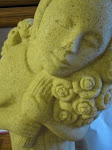On the afternoon of December 31st, 2008, I found myself on the concrete steps of the emergency room outside of Jawaharlal Institute of Postgraduate Education and Research (JIPMER) in
We are quite a pair, Amala and I. We met unexpectedly last August while I was leading my first “Child Leader Project Youth Leadership Programme” in Tiruchirapalli, a five hour bus ride southwest of the
Now, inside JIPMER, Amala searches desperately for “our” uncle
Although JIPMER is considered a state-of-the-art facility, it simply can not handle the volume of patients outside its doors. Families that have travelled from far away make camp outside its walls, laying on streets and cracked sidewalks, waiting for treatment. I had left the emergency room of bleeding and moaning human bodies for fresh air. Almost immediately upon my escape, a van sped down the road from the grandiose entrance of the hospital to the bottom of the steps before me. People rushed out of the van, sliding its main doors back to reveal a woman lain across a decaying backseat. Shielding my eyes from the afternoon sun, I was pushed aside by a stretcher marked “Burn Unit” and three young, Indian medical students rushing down to meet the open doors.
Amala came outside. “Look,” she pointed, “she has been burned.”
The woman was scorched. Her clothes had disappeared to reveal charcoal and ash. There was no hair on her head, no place to tie jasmine flowers to a plaited black braid, no salwar, no sari, nothing. A woman cried over her, reaching out to her as they placed her on the stretcher. My face revealed its horror, while, with eyes opened, they pushed the charcoal woman past me and into the emergency room. The van sped off down the road.
Amala continued, “She must have been cooking and her dress caught on fire.”
I knew that was a lie. “Cooking accident” was a euphemism for “domestic violence.” Dowry deaths and honor killings, commonly disguised as “cooking incidents,” were alive and well in
“Amala, we both know that was not a cooking accident.” Amala became silent. She looked around the yard of the hospital nervously, “Yeah. I know.”
The guard who, till this moment, had been standing vigilantly and silently by the door, offered me his stool. I looked up at him, “How many of those do you see each day?” Staring towards the path the van had taken, he stumbled over his words, waiving his hands in the air in a way that suggested something was quite commonplace about women made of ash. “I don’t know... 8...9... sometimes 10.” Amala herself had become curious, “Even with treatment, she will not survive, will she?” The guard shook his head.
This is only one story I have been a part of—many women, mostly in beauty parlours and women’s-only spaces, have shared similar stories of womanhood. In beginning to confront these issues, it must be made clear that my starting a nonprofit was never explicitly about women’s advocacy—it was about youth, education, international dialogue, and social change. CLP is an international organization that coordinates with local and international partners to connect youth and young adults to their international peers through collaborative leadership programming. Our leadership program is a wide and inclusive combination of higher education planning, conflict resolution training, discussions of values-based leadership practices, social service activities, and international dialogue through creative mediums. We work in partnership with Indian-based organizations that strive to bring the human right to education to all margins of society—the rural, low caste poor, slum and street children, and former child laborers.
But this work is more than women’s advocacy work. I am convinced of a paradigmatic shift on this last day of 2008, and I perch quietly as we scooter away from JIPMER, my arms wrapped around Amala’s waist. I am reminded of a meeting had the previous day in the lush village community of Little Kanchipuram, home to a 25-year-old NGO working for women and children’s empowerment in relationship to the stone quarry and silk mill industry. As I was slipping on my sandals at the door, the director of the organization stopped me outside to leave me with one last comment: “Samantha, Child Leader Project is Child Activist Project. You must consider the great implications of making these children into activists.”










No comments:
Post a Comment